Norway – the geological genius that mesmerises
you around every corner
Visiting Norway in a motorhome is a dream come true for so many. I can imagine that Norway has always been on your list and stories of the awe-inspiring scenery has you reaching for your map. And then the enormity of this Nordic northern land hits you firmly between the eyes, as you see its scope on the atlas in front of you. Now questions tumble through your mind about the journey to reach this iconic destination and how to get around this land of deep fjords and 3D mountains. Uncertainty and doubt may cloud your enthusiasm as the shadow of fear creeps across your excitement. What if there was a place where you could get all the knowledge you needed for travelling to Norway in a motorhome, helping you feel informed and confident about your adventures north?
Look no further – this series of blogs aims to demystify the plethora of information ‘out there’ in Google-land about getting to and moving around Norway. So sit back and feel the relaxation wash over you as you find your confidence for your impending trip. Our passion is helping you make that Norway trip a reality.
In this blog, we focus specifically on Visiting Norway – All things Travel related in your motorhome. We start with all the things you need to do before you leave home. Then factoring in things to do en route to Norway. And finally how to enjoy navigating around Norway using its ferry system, the road network, tunnels and tolls and overnight parking. For ease of planning, we have included relevant and helpful links in the text, which are highlighted in red and underlined. If you click on these, they will take you straight to that link in a new page where you can save it as part of your research.
As this is such a mega blog with a stack of information, we have popped a Table of Contents below so you can jump around the post with ease. We hope this might help you navigate through the information. So if you’re ready – here we go.
Part 1 – Before leaving home! Your checklist
- Assess the time you have available for your trip
- Plan your entry into Norway accordingly
- Register for your Autopass Ferry Discount Card
- Sort out your EPC registration – Euro Parking Collection
- Think about your Currency and Prepaid Cash Cards
- What to do if your vehicle is over 3.5T
Assess the time you have available for your trip
We support the notion that you must, ‘Travel when you can, as far as you can and for as long as you can’. Not everyone has the luxury, as we do of being full-time – we acknowledge that. Although having had 7 weeks touring Norway, we have come to respect its vastness. Whilst it may seem like a great idea to pop to Norway for a couple of weeks, if you are coming from the UK, then it is worth just doing a reality check.
You need to allow between four-five days to get to Norway, with your starting point at Calais; and that’s driving at least four hours per day, without any sightseeing.
Norway is long and thin. Whilst there is the E6, which is the main arterial route that goes from Trelleborg in the south of Sweden all the way to Kirkenes on the Russian border in the north, it’s a whopping 1,950 miles (3,140km). And it takes 40-50 hours to drive. That will give you a sense of Norway’s enormity. And when you deviate off piste to where, let’s face it all the best scenery hides, then you need to build in fjords, mountain passes, windy roads and ferries. There is no going anywhere fast in Norway because why do Norway fast when there is so much beauty to breath in?
We do implore you to be wise with your time and plan realistically for your trip. Take into account travel time to and from Norway. And then look sensibly and what you can achieve with the remaining time you have. Don’t overstretch yourselves and, if necessary stay south. Travelling is tiring and say that from experience. Whilst four hours on the road may sound achievable, when translated into travelling in Norway, you can expect 4 hours to be more like 6. Add the concentration factor required for mountain driving and it makes for a completely different travel strategy.
We say this, not out of any sense of fear. We just want to help you plan realistically so that you get the best out of your Scandinavian experience.
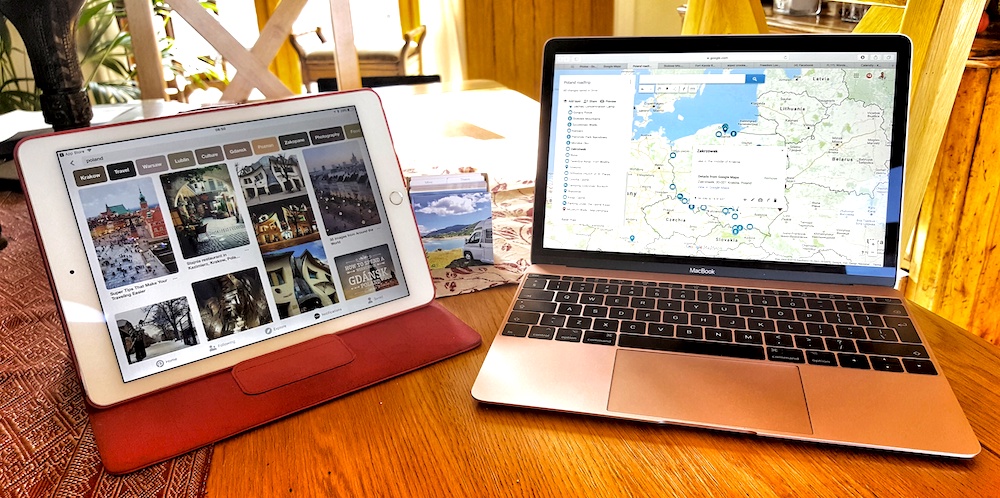
Plan your entry into Norway accordingly
We will, for the purposes of this blog, assume that you are travelling to Norway in your camper or motorhome. From this point we can now look at the main entry points into Norway. This will allow you to judge the best route given the available time.
There are four main entry points;
– Via ferry from Denmark to south Norway or Sweden
– Via ferry from northern Germany to Denmark/Sweden
– Via road, crossing Denmark’s Øresund Bridge into Sweden, entering Norway just north of Strömstad
– (And for completeness we need to mention the route through the north of Finland and Sweden)
Denmark options
1. Hirtshals is the most popular route for easy and direct access into Norway. Served by 10 daily sailings to a range of destinations that include Bergen, Kristiansand, Stavanger, Langesund & Larvik. The ferry durations range from 2.5hrs for Kristiansand to 16hrs to Bergen. Prices will obviously depend upon the season you travel and the length of your vehicle. For more information check here.
The advantage of the Hirtshals route is that it gives you direct access to southern Norway and the option of entering at one port and returning from another to give you a circular route. You also have the opportunity of seeing Denmark, which is well worth exploring, if you can build in the time. For more information on Denmark check our blog here.
2. There are other routes to Sweden you could consider, which include Frederickshavn to Gothenburg, Grenaa to Varberg or Helsingør to Helsingborg. The latter is the quickest way to cross the water, taking just 20 minutes. For information on this route check here.
Germany option
Again assuming we’re focusing on a UK starting point; then you could sail from Travemund to Malmö or Trelleborg in Sweden. Or from Rostock to either Trelleborg or Gedser in Denmark. The latter means you avoid one of the two Danish bridges (Storbælt). Although you will still need to cross the Øresund Bridge to get into Sweden. Rostock offers up to 18 daily sailings with durations from 1.45hrs – Gedser to 6hrs – Trelleborg. For more information check here.
Øresund Bridge route
If ferries aren’t your thing and you would prefer to drive and take in the sights of Sweden’s west coast, then crossing the Øresund Bridge is your option. From mainland Denmark, you travel to Odense via Middelfart. I mention this partly because I just like saying the word, (with a childish titter) and also because it has one of Denmark’s only LPG stations. (55.492748 9.759738). It’s like gold-dust, so get some!
Considerations when taking this route is that there are two bridges to cross. The Storebælt and the Øresund, both of which are chargeable. The Storebælt is a beautiful 11 mile (18km) structure that is payable at a Toll Booth. You can pay by cash, Euros, Krone or credit card. Prices are based on the length and height of your vehicle. Based on 2019 prices for a camper/motorhome over 6m long and max 3.5T it will cost €52; €85 if you are under 10m and over 3.5T. Make sure you take your registration paperwork in case of any dispute about charges based on your length. (Remember you must include any trailers or bicycle racks in your total length).
The Øresund Bridge is a magnificent piece of engineering and it was on Myles’ Wish List after seeing it from a plane many years ago. It’s a road and rail route to Sweden and is just under 10 miles (16km) long including the tunnel. It’s quite a sight. This is another toll bridge and if you plan on returning from your Norway trip this way, then it is worth buying a Bropas. It’s an annual pass that costs around £37 to register, although it will save you 50% on each of your crossings. Given the fee to cross is €124 (summer price – out of season is slightly cheaper) then if you come back this way, the Bropas is worth having. If you are unsure about your route home, then we would recommend simply paying the one-way fee although if you do it ON-LINE at least one hour before you cross, this will save you 10%. Here’s the link. The purchase is valid for up to 30 days should your plans change.
Once in Sweden then it is very easy to pick up the E6 from Malmö and blast up to the Norway border just north of Strömstad. This will take you a minimum of 5 hours from tip to toe. So if you can, we would highly recommend taking the scenic route and extend your stay by 2-3 days. Experiencing the beautiful west coast of Sweden is a must in our book. The Bohulsän region is incredible with archipelago stretching from Gothenburg to the Kosterhavnet National Park on the Norwegian border. We adored our time here and the ferries are FREE. Wild camping in Sweden is so easy and although there are some restrictions in this National Park area, we found places to stop without any issues.

Register for your Autopass Ferry Discount Card
This is a critical action point to tick off your list before you leave home. This is a new scheme for 2019, so this is brand new information that will save you HUGE pennies on your Nordic budget. And I mean HUGE – up to 50% discount.
Norway’s lifeline is its ferries. Without them life would become very congested and difficult. So using the ferry system will be very much part of your Norway travel strategy. So here are some important steps that we highly recommend to getting registered with your Discount Card.
The essence of this card is that you;
- Log on to the Autopass website and register with your home address and vehicle licence plate. Autopass then send you a confirmation email within a couple of days giving you an IBAN and Swift number. This is for you to send a deposit amount to your account to pay for the ferries.
- Then you arrange an international transfer of 3,500NOK (£325.00) to your Autopass account. We did this through our online banking with Barclays. There will be a small cost to do this based on your bank’s International Transfer arrangement. Within 3-4 working days you are then able to access your Autopass account and see your deposit funds. They will take 27NOK for the printing and sending of the plastic card.
- Once funds have been received they then send your card to your home address within 7-10 days. This little golden nugget then needs to be shown when you arrive at the ferry ports in Norway. The ticket man swipes your card and payment is taken like a credit card. No cash is needed. It’s as simple as that. You can check your accounts for the bills that appear within a week or so of your first ferry.
- At the end of your trip, you simply log into your account and terminate the card and all money remaining is refunded back to your nominated bank account within 30 days. Ours was returned well within this period.
It’s worth mentioning that we did come across one problem where our card wasn’t recognised and we had to pay by credit card. We advised Autopass of this and they asked for a photo of the receipt and they agreed to refund us the 50% discount we should have received. We were very impressed with this system and the savings were well worth the effort.
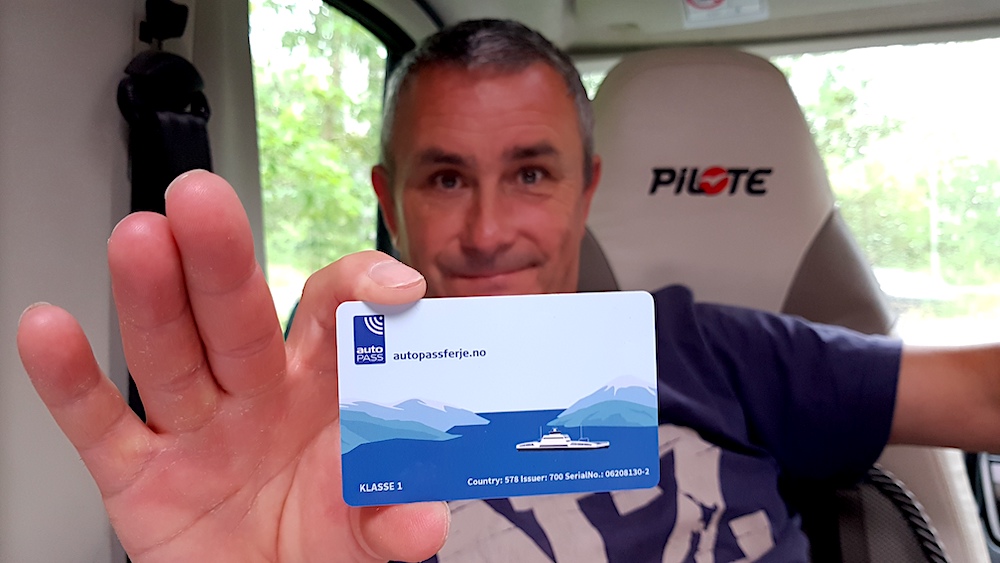
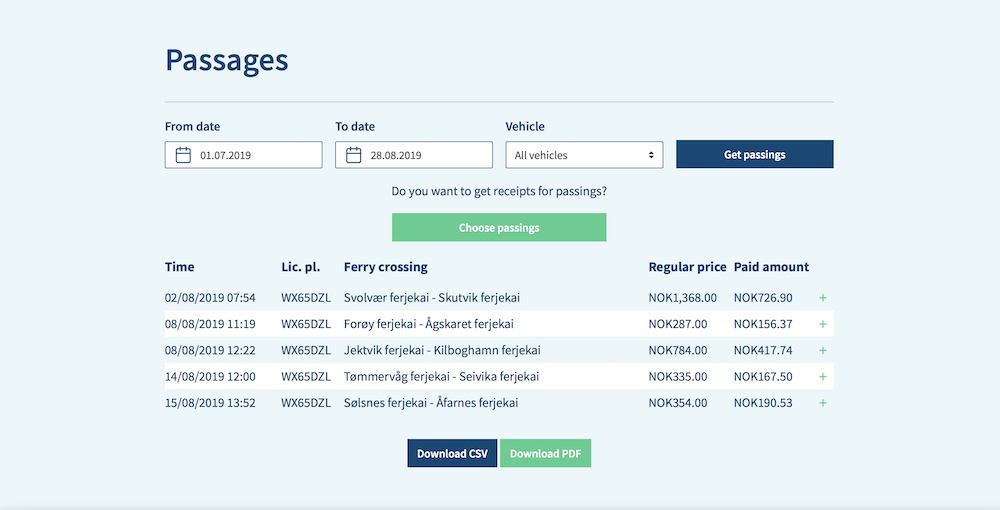
Sort out your EPC Toll Account – Euro Parking Collection
Another cost to plan for, before you leave home, is Norway’s tolls. Roads, some tunnels and a few bridges have automated tolls and whilst they’re not expensive you are required to pay them as a visiting foreign vehicle.
Every toll, bar one is operated by Vehicle License Recognition. So cameras pick up your licence and EPC, on behalf of Norway’s road system, will invoice you through information registered with the DVLA. Whilst registration with EPC isn’t obligatory, it’s worth doing so that you can access your accounts and manage the bills. You can also assign a credit card to your account so that automatic payment is taken. Otherwise invoices will be sent to either your home address or you can nominate an email address to get them sent directly to you.
A word of caution. It takes forever for the bills to come through. It took over three months for our invoices to come through. And because of the duration, we suggest you write down your tolls so you can check them off when they come through – the costs are clearly indicated on the road signs.
You can find out more and arrange registration with EPC by clicking this link Euro Parking Collection. It’s worth doing so that your passage through Norway is automated and simple.
The only toll that you pay at a Toll Booth is on entering the Atlantic Highway Route 64 at Kristiansund on the west coast.
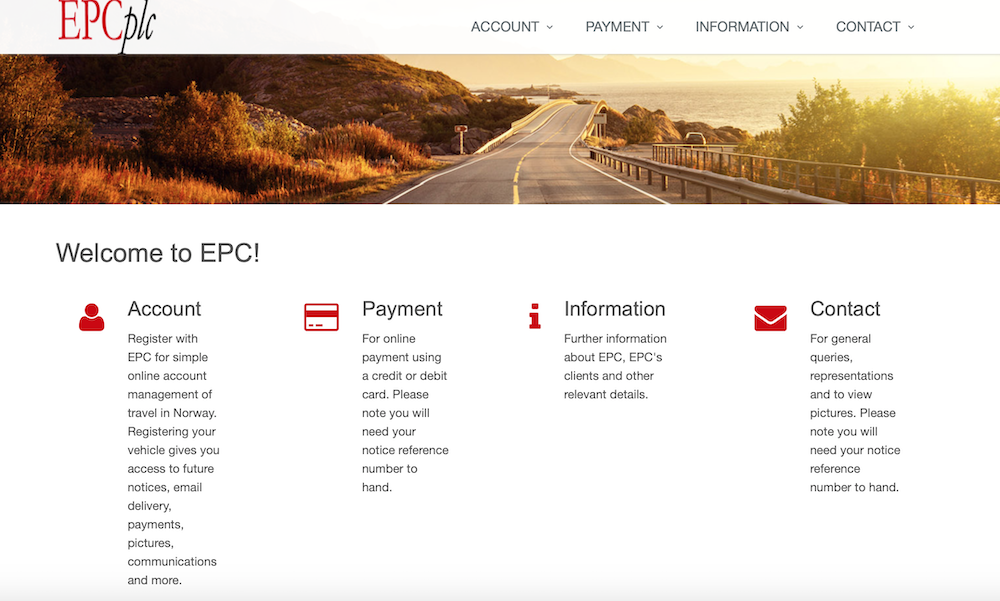
Think about your Currency and Pre-paid Cash Card
Norway, and in fact Denmark and Sweden all have their own currency. Whilst there are some places that accept Euros, these are generally few and far between – and only in very touristy areas. So make sure you arm yourselves with some NOK – Norwegian Krone. Whilst most of Scandinavia is a cash-less society, there are times when having a bit of cash is appropriate. For example some Marina Aires have an honesty-box payment system where you pop your money into an envelope and some campsite washing machines require coin operation. Everything else is card!
The amount of cash you take really depends on your length of stay and what your preferred style of overnight stops is. If you prefer wild camping then you’ll need no more than an equivalent of £20 of Krone per month, that will give you around 220NOK (@8/2019).
If you would rather stay on Marina Aires then you may need significantly more. The few Aires we stayed on were between 150-200NOK per night so that will give you a feel for what you might need to take with you. For all other payments we used our pre-paid cash card from Caxton – others are of course available.
A point to make with regards to paying for Diesel at Petrol Stations with your pre-paid cash card. For every fill up we had a deposit amount taken from our account and your statement will show up as PENDING. This is a security deposit and is returned to your account as soon as payment has been received by the supplier. So don’t be anxious if you see a larger amount appearing on your statement than your receipt shows. It will be refunded within 5 working days, often it is a lot quicker than this.

What to do if your vehicle is over 3.5T
Norway’s Roads and Ferries are all about length. Charges are made based on length categories. So generally speaking you would see <6m, 6.1-7.00m, 7.01-8.00m, 8.01-9m and >10m. So given the size of your vehicle you may need to think about an electronic TAG device.
Given our vehicle is 3.5T we have no direct experience to share with you. Other than talking to friends who have just travelled to Norway with their 9m truck plus motorbike trailer. So at the very least we wanted to pass on this information to you. We hope it helps.
A Tag system is the best option and there are a number of companies who supply this physical device. Our friends chose EasyGo+ Brobizz as it can be used in both Scandinavia and Austria. You make your application online from their website, sending them a copy of your V5 and your emissions category, if this is not listed on your V5. They then set up a contract for you and a Tag device is sent to you within 10 days of your application. The beauty of this system is that you can use this device for your tolls (for which you also get a discount), ferries and across the bridges in Denmark. So it does have some advantages and of course is a necessity if your vehicle is over 3.5T. Our friends said it was very efficient, with bills coming through within 48hrs of their crossing through a toll.
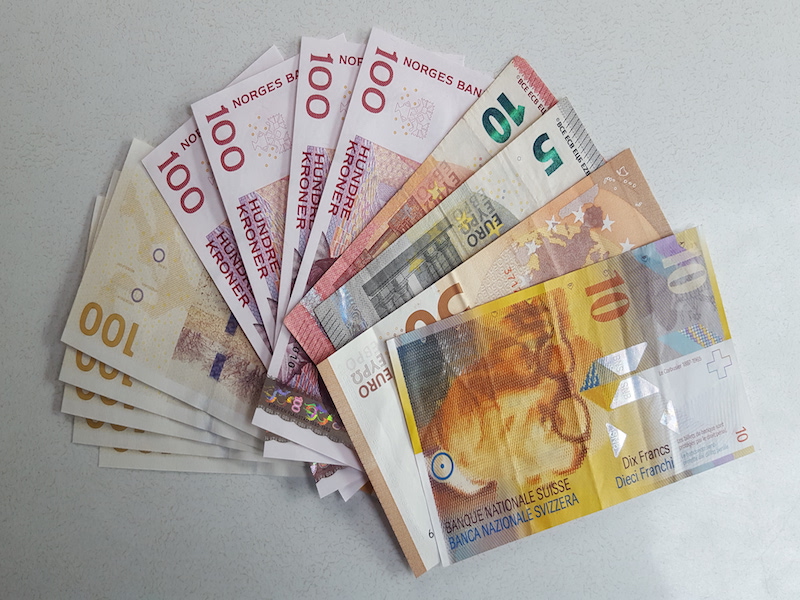
Part 2 – We’re on the Road to Norway
Make it about the journey
The best bit about travelling is that it is as much about the journey as the destination. It might sound a bit of a cliché, although it’s so true. We all fall foul of the, ‘get there quick and then we can rest’ approach. Although as we have already said, travelling through Norway’s vastness is tiring. So en route why not check out Bruges or Ghent in Belgium. Or perhaps Zeeland or Giethoorn in The Netherlands appeals as you break up your journey.
Either way, as Norway beckons, you have to navigate the river Elbe in northern Germany. One option is to go around Hamburg’s autobahns. This is our idea of hell. So after a bit of research I found an alternative route across the river at Wischhafen. There are 3 Aires not more than 5 minutes from the ferry and with regular sailing times, getting on quickly is never a problem. The journey takes 30 minutes and costs in the region of £20 (based on 7.5m plus two adults.) It puts you in at Glückstadt, which is just 2.5hrs to the Danish border. There’s also a Lidl nearby for stocking up on supplies and plenty of cheap Petrol Stations and LPG filling opportunities. It’s worth filling up with both before you cross into Scandinavia. Check out our Wischhafen Ferry video here. It was a great find.
Stocking up – a word of caution
Norway is notorious for its high cost of living especially the alcohol. So advice is to always fill up before you cross the border. Although a word of caution. Depending upon where you cross into Norway, there are credible reports from both locals and travellers that Customs Officers are a bit frisky with searching vans for excess supplies. Especially, we hear, off the Hirtshals’ ferries. So be mindful of this.
One report was that the vans were being strip-searched at their arrival in Norway. The country is not part of the EU, so they have Duty Free limits. So this might influence your route into Norway based on your love for booze. We crossed in the north of the country where there were no Customs checks so had no issues. Also as we crossed back from Norway into Sweden south of Oslo on the E6, we didn’t see any hard-border checks there either. So it does appear only to be off the Denmark ferry routes.
Part 3 – Travelling around Norway
Velkommen til Norge
So after all those months of planning, you have finally arrived at your dream destination. Norway yeah! Here are a few essentials about getting around Norway safely.
- The road system, tunnels and bridges
- Filling up with Diesel and LPG
- The ferries
- Camping overnight
- Travelling with dogs
The Road System, Tunnels and Bridges
Norway’s roads are pretty good and I say this having driven through Bulgaria, UK and Italy. Whilst they are not the standard of southern Sweden or Spain, they are of a reasonable quality. The key thing to remember about Norway’s roads is that there is always some sort of repairs happening. Given that the conditions are so bad from November to March, they use the summer months to repair and strengthen their roads. So be prepared for long stretches of road-works and delays. We got caught up on a road where they were shoring up the side of a mountain and they required 2 hour periods to do their work. So watch your SatNav and the road signs. We also experienced 40 miles of intermittent road resurfacing on the arterial E6, which made it a horrible journey south and we had to pay for the privilege of it too.
Otherwise the main roads we found decent enough. If, like us you enjoy getting off the beaten track then the road quality does become markedly differently and they tend to be more narrow. Passable, although narrow. So driving with caution and slowly are the name of the game. This is why you don’t get anywhere quickly in Norway.
One thing we came to value perversely, on all roads in Scandinavia, are the rumble strips you get on the white lines in the middle and at the right-hand edge. We all have momentary lapses in concentration and a slight wander left or right happens to us all, let’s face it. Especially with all these magnificent views. Although you are soon corrected and accidents by wandering vehicles are prevented by these rumble strips. A sensory warning to adjust your road position! They send vibrations right up your bottom!
A word on Norway’s motorways! They’re not really motorways as we know them. The main E roads, such as E6 are just single lane roads for much of the time. There are occasions when they are two or three lanes, especially around cities, although never for long.
There are oodles of tunnels and bridges linking this geological masterpiece together. Tunnel lengths vary from just a few metres to our longest one, which was 8 miles! Friends travelled through the Gudvanden tunnel on the E16, in west Norway (60.888023 6.863913) and in August 2019 reported that the road surface was broken up for about 2.5 miles in the middle of the 7 mile length. So this might be one to check out prior to travelling.
In the north we found the tunnels were less… what shall we say… refined as their southern comrades. The walls were not coated and smooth, they were quite literally a hole through the mountain sides. So a little courage and a bit of praying that nothing was coming the other way, was needed at times. Certainly the longer tunnels in the south were of a much better quality we found, with good lighting and plenty of information about your position in the tunnel. If you are in the north around Tromso, enjoy the delights of having a roundabout in a tunnel. Yes you heard right – a roundabout. What a bizarre experience that was.
The bridges in Norway are a piece of art in themselves. With arches, curves and suspensions you will ‘wow’ just over the bridges. They are an experience and always a positive one, in our opinion. The only issue I can think of is the weather conditions. If there is a nifty wind then you may need to proceed with caution although generally you are informed of the windspeed if there is an issue on a particular bridge.
The speed limits in Norway are clearly marked although as a rule, in built up areas it is 30mph (50km) and on the main roads between 40-50mph (70-80km). Some sections of the E6 you could do 55mph (90km) although not very often. There are cameras so do keep to the speeds.
In terms of the season you visit, just be mindful of the risk of snow. Whilst from May to September there is low to no risk, the further north you go the more unpredictable the weather. So if you intend to come early spring or in autumn, as a precaution pack snow-tyres or at the very least snow-socks. They could be vital in getting you out of a freaky weather system.
For all up to date information on driving in Norway, check out this website.


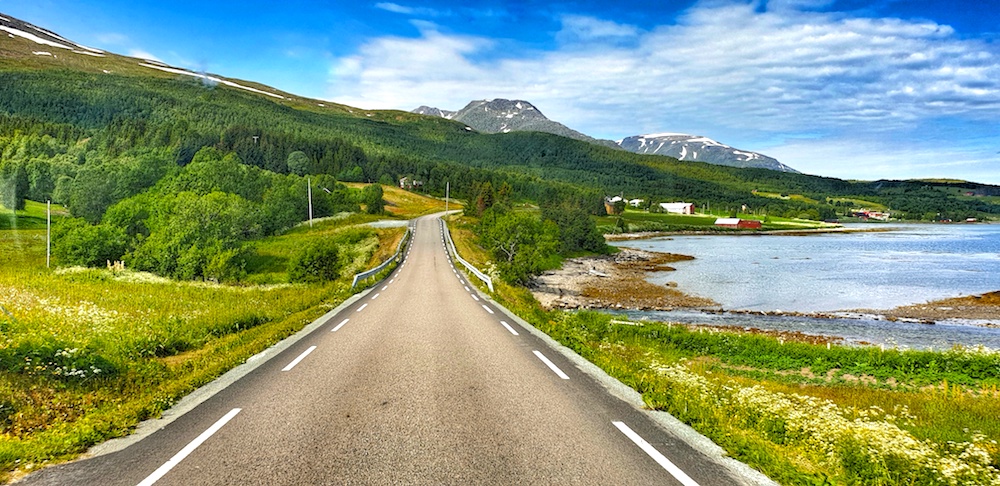
Filling up with Petrol and LPG
Norway has plenty of Petrol Stations even throughout the fjords. Although our advice is always fill up when you can so that if suddenly resources become scarce you don’t have a problem. Interestingly LPG stations are less frequent although sufficient we found, for our needs. Travelling to Norway in the summer means generally no heating will be required so our two 11kg tanks lasted us 4-5 weeks, roughly. If you come during the autumn then you may need to be more mindful of where your LPG stations are, given that the weather is more unpredictable and snow can come early to this Nordic northland. We use the App LPG.eu and Maps.me to check where the nearest stations are.
LPG stations are not housed within Petrol Stations. They are separate entities, usually found in Industrial zones on the outskirts of towns.
We were interested to watch the prices of diesel over our 7 weeks. The first observation was that the price of diesel is actually cheaper in Norway than Sweden. We averaged between 13.39 and 16.05NOK (£1.22 – £1.46). All stations were self-service and a majority of them payable at the pump rather than in a kiosk.
One thing to remind you about is that in Denmark, Norway and Sweden a deposit is taken from your card of roughly 800 Krone, irrespective of what you spend. This is then refunded to your card within 2-5 working days. So don’t be shocked at the amounts on your statement. We suggest keeping hold of your receipts until the held amount is refunded in case of dispute. Although we always had ours refunded.
The second observation is that the price can change within an hour – so if you see it cheap buy it – even if you don’t have an empty tank. And that change could be up to 1NOK so it makes a difference to your pocket.
And finally, Sunday was always a cheap petrol day – we’re not sure if this was just coincidence although we often saw prices change come Monday morning. So worth watching out for. There doesn’t seem to be any one petrol station cheaper than another, so just go for the cheap prices when you see them, is our advice.
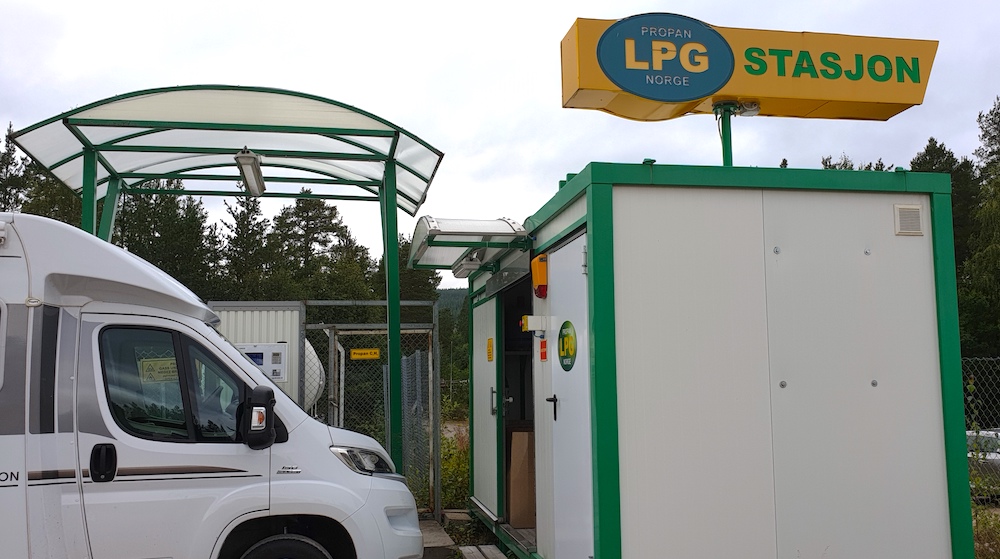
Navigating the Ferries
As we have already discussed, the ferries in Norway are a necessary part of their lifestyle and very much part of their culture. Hopefully by now you will have been persuaded to get a Ferry Discount Card. This section is more about the practicalities of ferry travel once you are here. There are a few pointers we have to ease your journey.
- The 8 ferries we experienced on the west coast, mid-coast and the Troms region in the north were very efficient, and frequent. You never seem to be waiting long, especially once you are south of Bodø where their schedules are incredibly regular. I guess because the ferries are shipping cargo lorries as well as leisure vehicles, you can see why their frequency is important.
- For 5 out of our 8 ferries, we were able to use our Discount Card. Our last ferry, for some reason wouldn’t accept our card, so we have informed Autopass of this malfunction and they will be issuing us with a refund.
- There is a lane queuing system for each ferry and depending upon your position in the queue you will either get on the current ferry or automatically be first on the next scheduled sailing.
- In terms of payment, generally a ticket collector would come to you whilst you are waiting in the queue and take your card. On the odd occasion you would pay the ticket collector on board the ferry.
- Embarkation and disembarkation were swift, painless and given most ferry’s capacity was about 50 vehicles you could generally assess whether you would make it on. There are toilets and some refreshment facilities depending on the length of the journey and you are allowed to get out of your vehicle, including your pets.
- You are required to turn off your gas for each journey.
- For the Troms ferries in the north, they have their own system and the Ferry Discount Card does not apply. We suggest that you download the Troms Mobillett App which entitles you to a 25% saving on all ferries in the region. It is also a facility you can use for taking the bus whilst visiting Tromsø. So it is a good resource to have. One HUGE tip though. DO NOT buy your ticket through the app UNTIL you know you are on board. There is a time limit to your ticket purchase and it is important to only press the BUY button once you are securely parked on the boat. Otherwise your payment will run out before the ferry arrives. For the Troms’ ferries you need to present your ticket onboard at the ticket desk inside the boat. You simply show your confirmation from the app and that’s it!
- And last and by no means least, the ferry to Senja from Brensholmen is the smallest ferry we travelled on with only room for 21 vehicles. So we strongly recommend that you check the schedule. This was our first ferry and we were lucky that we happened to be vehicle 11. We had no idea how large the ferry capacity was and there were only a couple of ferries a day. So you could end up waiting a long time if you get your timing wrong.
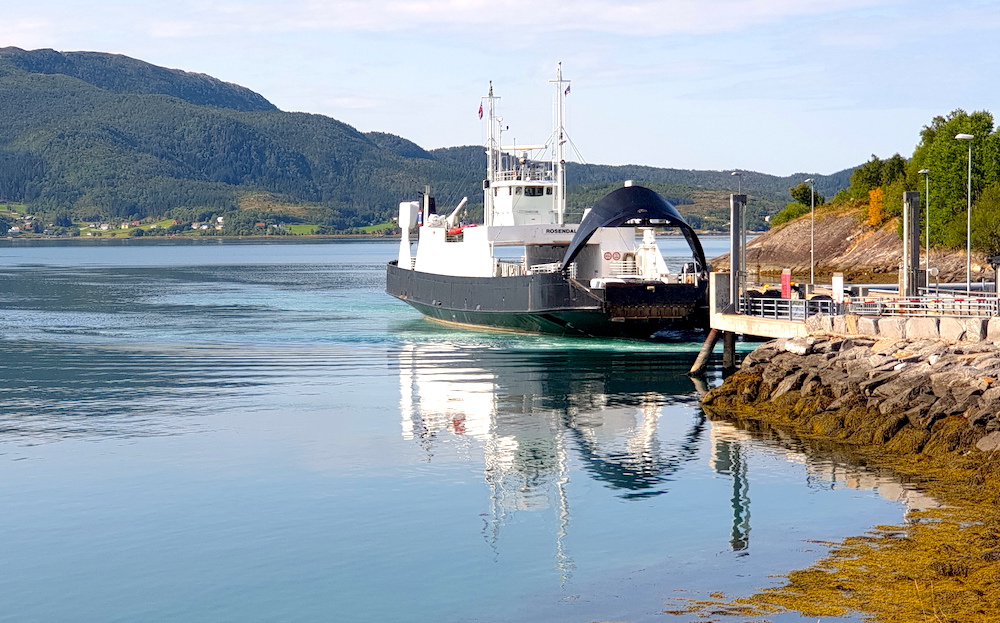
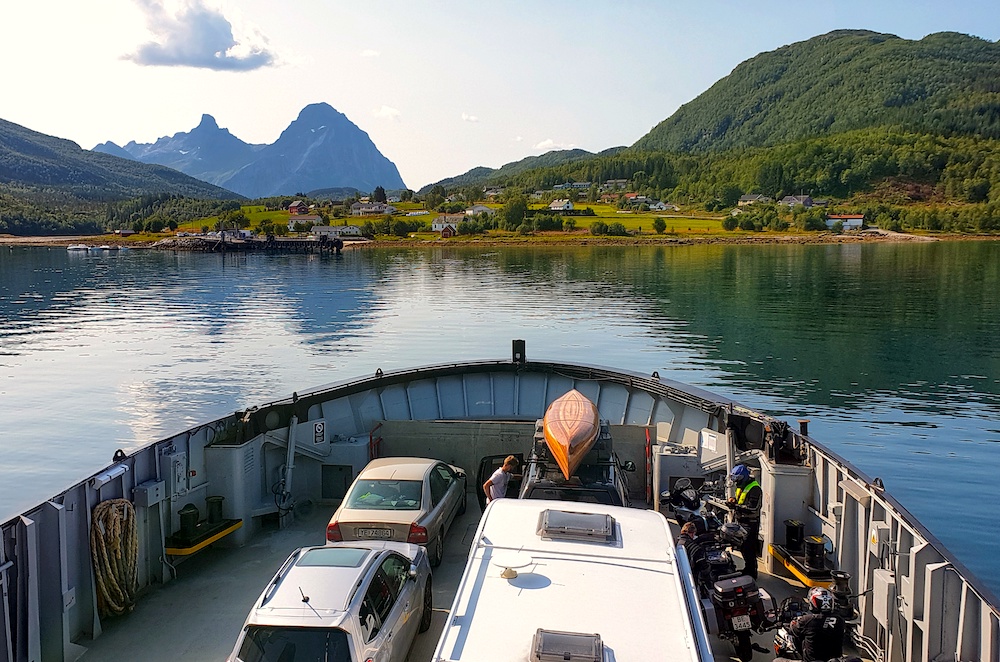
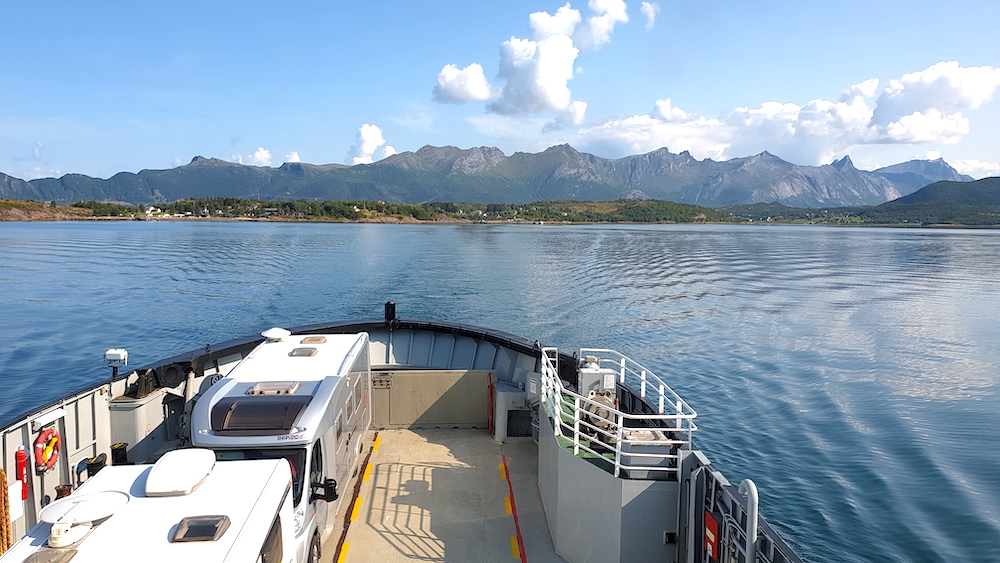
Overnight Stops
With all this travelling, you will want somewhere to rest your heads. And one thing that Norway does incredibly well is wild camping. We had some amazing spots alongside fjords with dolphins. It’s what wild camping dreams are made of.
Although if you prefer campsites then there are enough of those to go around too, although you may need to plot your journey a little more carefully on a day to day basis. I say this only because they are not on every street corner and so you may find yourself driving a long way to get to a site that is either booked or a longer journey than you had intended. Although in the three campsites that we stayed at during our 7 weeks in Norway, they were not fully booked, which did surprise me. They were busy although not a Spain-type of busy. That said, I would still do a bit more planning if campsites are your preference so you can judge your driving time right. For campsites, check out Search for Sites or Park 4 Night.
For wild camping lovers, we used Park4Night much of the time and we also found our own spots along the way too. Honestly finding places to park up is not difficult. You can often be guided by the trail of other motorhomes. You find yourself commenting ‘Oh well done, nice spot’. Or if you are tired and grumpy, ‘Oh damn that would have been perfect!’ Either way a place to call home is never a hardship in Norway. With their Allemannsretten – Every man’s right to roam, you can pretty much park overnight anywhere. As long as it is 150m away from any house and not on private land. You are generally allowed to stay for one night, although there are some mountain places where you can certainly stay longer.
The obvious next question is what about services? Well there are plenty of options we found. Some garages have free services, there are regular places in towns that offer facilities too and of course there are campsite options if you wanted. The only place we really struggled was on the Lofoten Islands. Otherwise even on Senja in the north, getting your van serviced was a complete breeze. We never worried about getting water or emptying our black waste. We do have the luxury of two cassettes, which does make a difference, although still we didn’t find any issues. Norway (and Sweden) seriously know how to cater for the motorhome community. In fact as you drive around the country, you will see how many houses have a motorhome in their driveways. They are into motorhoming in a big way and with winters as harsh as theirs, you can understand why.
Check out our gallery below sharing just some of our wild camping spots and campsites.
Travelling with dogs
Even though we don’t have a dog, I think it’s important to mention the regulations that you will need to consider for Norway. The following official website from the Norwegian Food Safety Authority gives you all the information you need to make sure your pooch (and cats or ferrets) can travel with you. In essence their checklist states four obligatory requirements. For more information if this is relevant for you, click the above link.
- The animal must be ID-marked
- The animal must have a valid anti-rabies vaccination
- The animal must have received an anti-echinococcus treatment (dogs only)
- The animal must have a pet passport
Conclusion
So Norway – a dream destination for nature lovers, motorhome travellers, hikers and photographers. It has so much to offer and is well worth the planning, preparation and journey to get there. We are pleased with the research we did, plans we put in place and the whole experience of Norway. So much so, that it contributes to Scandinavia being a serious highlight of our nomadic journey since March 2016. Whilst it took us a while to get here, it has really been worth the wait.
We hope that with these links, guidelines and pointers that you too will put Norway – and indeed the whole of Scandinavia on your list. This is just one in a series of blogs and free resources that we will be sharing with you to inspire you to travel to Norway and make your journey easy, cost effective and memorable.
We invite you to come back here for updates and visit our FB page for more information. There is be a free eBook that you can access by clicking here.
If you liked it, please Pin it!
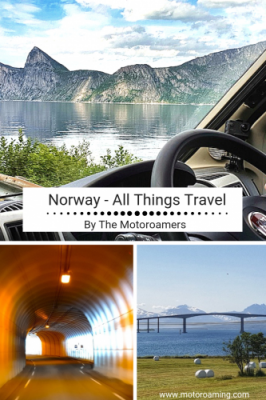


Check out our All Things Norway Series

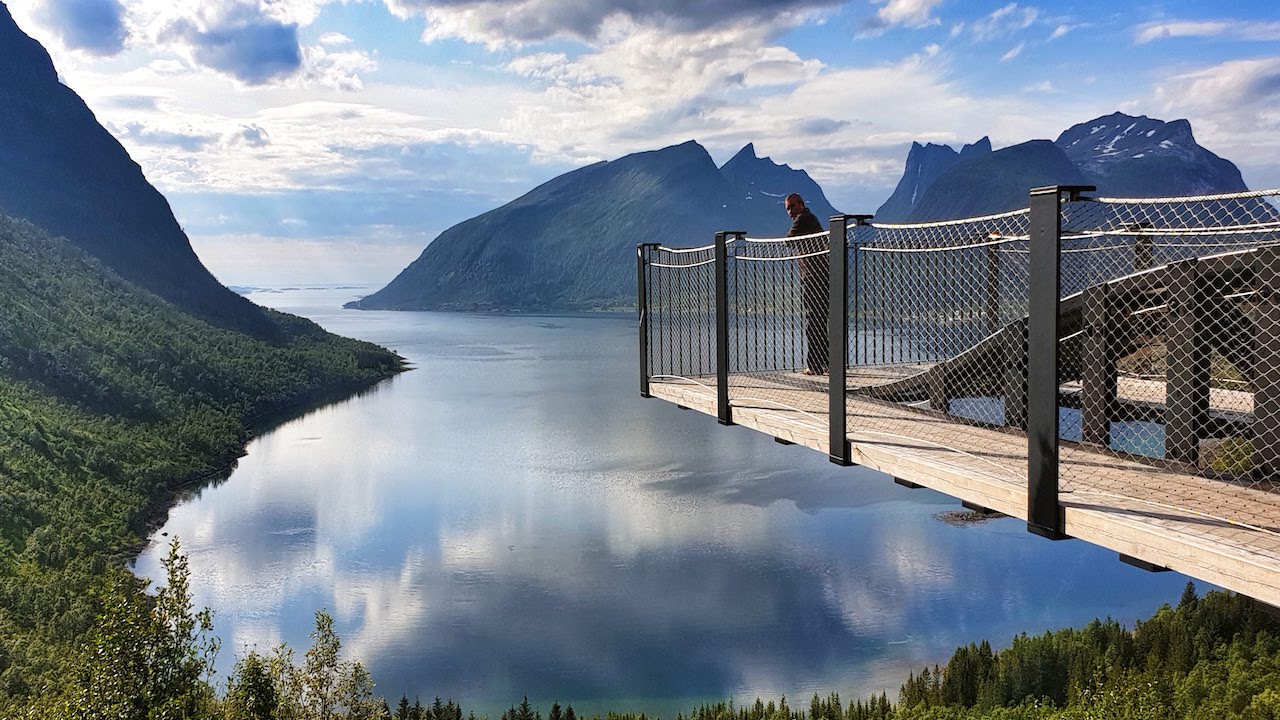


Love that you have taken time to make the guide thorough and detailed. I am truly inspired to travel to Norway.
Hi Sharon, thanks for saying. It feels important to share our experiences – good and bad. I hope you get there, it’s a sensational place. Kx
Wow, now that’s a blog entry. Excellent info as usual guys. Thank you very much. Your blog will be out go-to “Bible” for when we eventually full-time in 5 years time. Right now I’m absorbing as much as I can though. 😊
Hey Shug, lovely of you to say, thanks. Five years – it’ll fly. Kx
Great information! If I ever go to Norway, I’ll be sure to reread this blog.
I hope you do get a chance to go Alma. It really is a gorgeous part of the world. Kx
Thank you. Looks beautiful! We’ve wanted to plan a trip to Norway so will save this for then.
Perfect Amy. It does require some planning although once there, what a dream it is. Kx
You have thought of EVERYTHING to include in this blog! Loved it. Saving for down the “road” when I hope to visit some of Europe via camper van.
Thanks for such a detailed post. Norway is one of the countries that I hope to get to someday. This will be a huge help!
Hi Nancy, thanks so much for your feedback. Hopefully it will help you when you finally travel to this mega beautiful part of the world. Kx
Hi Both, many thanks for the informative blog, absolutely brilliant. Keep them coming.
I didn’t appreciate how much planning we need to do, your insight is going to be invaluable to us.
Our plan is to visit in June 2021 (50th Wedding anniversary) so hopefully we have a little time on our hands to get it all together.
1 question for you? I notice that in a previous financial blog that you had Zero cost against medical insurance. Would you like to share your thoughts on your take on it.
best regards
Brian
Hi Brian, thanks for your reply – so glad that it is and will be helpful to such an important celebratory trip. 50th Anniversary, wow congratulations. Our 30th next week.
In terms of Health Insurance – for the first two years of being on the road we had insurance with Holidaysafe who had a long-term Backpackers Insurance that allowed us to travel full-time with cover up to 2 years – with two three week periods returning back to UK. Although given our EHIC we decided to make do with this for the foreseeable future. We have talked to lots of people who travel long-term and many of them felt that taking this route with EU reciprocal health care being so good, that we opted for this route. If Brexit is carried through then we will take out insurance from this point forward given that the EHIC will disappear so all future budget costings will include this annual outlay. I suspect we will go with someone like World Nomads who have a more flexible cover option than most in the UK who have policy limits of 90 days. Whilst the Schengen Zone issue will give us an issue, our plan is to either get travel visas to allow us great time in EU or visit countries who don’t belong to the Zone. So I suspect that no UK insurance companies will cover us with our full-time needs. It’s all a bit unclear at the moment although that’s where we stand at this point in time. Hope that helps. I’ll email this response to you as well, in case you don’t pick up our response here. Karen x
Thanks so much for the info, we have just applied for the ferry discount card and EPC account ready for a 5 month trip across Northern/Eastern Europe starting next April, crossing to Helsinki, with the intention of being a couple of months in Scandinavia, mainly Norway. Just a quick question please – are the discounts worth getting a toll tag even if the van is under 3.5t ?
Keep up the good work, your blog has been invaluable, both practical and inspiring for a couple of early retirees filling half the year on the road. Happy New Year 😀
Hi Mike, I have dropped you a direct message. In essence though the Toll Tag for under 3.5T I don’t think will save you anything as the tolls are actually not expensive in comparison to other costs in Norway. Have an amazing trip and do get in touch if you have any other questions. Kx
Huge thanks for all your hard work writing this – we’re off in early May for an extended trip hopefully all the way up to the top!
You’re very welcome. You’ll have a great time. Enjoy.
We love your web site and for the last 2 years have planned to go to Norway ( thanks covid) and your site has been a massive help, so much info I would never have thought of. Fingers crossed next year 2022 we will make it. I notice you have bikes with you, we have electric assist bikes is it worth taking given the weight and space.
Terry & Lesley.
Hi Terry and Lesley, so glad to hear that our site and information has been useful. We really hope that Norway comes off for you next year. Keeping everything crossed. In terms of the bikes, we too have electric bikes and they come with us everywhere. Even if you don’t use them much in Norway, the journey to and from I’m sure they will be invaluable. So yes I think they are very much worth the weight and space. Whilst we didn’t use them very much in Norway, they are good to have with you so that you have options for getting around. There aren’t many buses over there! Hope that helps. Let us know how you get on. Karen x